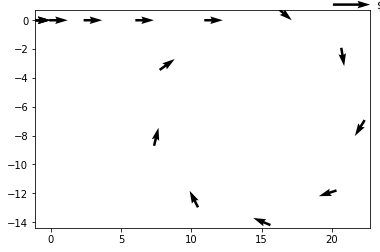01. Project Overview
Lab Overview
In this project you will take raw sensor data like this:
| timestamp | displacement | yaw_rate | acceleration |
|---|---|---|---|
| 0.0 | 0 | 0.0 | 0.0 |
| 0.25 | 0.0 | 0.0 | 19.6 |
| 0.5 | 1.225 | 0.0 | 19.6 |
| 0.75 | 3.675 | 0.0 | 19.6 |
| 1.0 | 7.35 | 0.0 | 19.6 |
| 1.25 | 12.25 | 0.0 | 0.0 |
| 1.5 | 17.15 | -2.829 | 0.0 |
| 1.75 | 22.05 | -2.829 | 0.0 |
| 2.0 | 26.95 | -2.829 | 0.0 |
| 2.25 | 31.85 | -2.829 | 0.0 |
| 2.5 | 36.75 | -2.829 | 0.0 |
| 2.75 | 41.65 | -2.829 | 0.0 |
| 3.0 | 46.55 | -2.829 | 0.0 |
| 3.25 | 51.45 | -2.829 | 0.0 |
| 3.5 | 56.35 | -2.829 | 0.0 |
and turn it into plots of vehicle trajectories like this:

Data Note
The above is just example data, and not from real sensors - as you might notice, acceleration of 19.6 m/s^2 from 0.25 to 0.5 seconds would result in a velocity changing from 0 to 4.9 m/s. If this was a consistent velocity, the displacement would be the velocity (4.9) multiplied by the change in time (delta t, or 0.25), resulting in displacement of 1.225, as shown above. However, in reality it would likely be closer to constant acceleration (instead of constant velocity) during this period from 0 to 4.9 m/s velocity, so displacement would actually be 0.6125. We've simplified the calculations for our examples in this lab.
Instructions
Instructions for this project are included in the project notebook in the next section.
Note that this project is not submitted and will not be reviewed by a Udacity reviewer. This means that you can complete this Nanodegree without completing this project (but we recommend you complete it anyway).
If you want to ask questions about this project or share advice and code, post in the Study Groups or Knowledge.